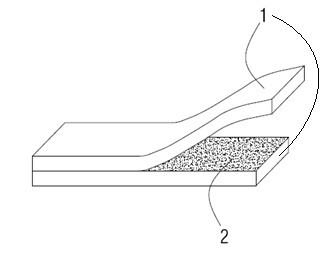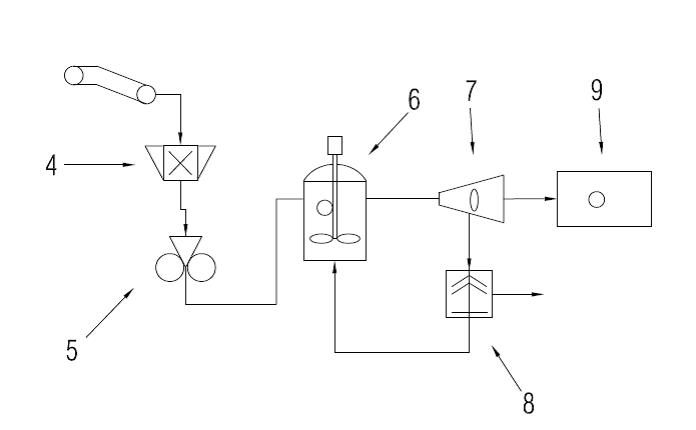Never miss an update from Universidad de Alicante
Create your free account to connect with Universidad de Alicante and thousands of other innovative organizations and professionals worldwide
TECHNICAL DESCRIPTION
The research group, 'Engineering for Circular Economy (E4CE)' of the University of Alicante, has developed a procedure for removing the adhesive that holds the laminated plastic sheets (Figure 1) together, and the subsequent removal of the ink. This procedure facilitates the recycling of each of the plastic materials in the composite material.

Figure 1. General diagram of a laminated plastic material, comprising at least two layers of plastic material (1), and an interlaminar zone (2) between the two layers of plastic material (1).
This procedure consists of the following steps (Figure 2):
1. Conditioning and crushing of the laminated plastic material previous treatment (optional).
2. Micro-perforation of the laminated plastic material.
3. Removal of any ink or adhesive.
4. Separation of water from the plastic material.
5. Removing of any ink or adhesive from water.
6. Separation of plastic materials.

Figure 2. General diagram of the stages for the elimination of adhesives and/or interlaminar inks in laminated plastic. 4. mill; 5. microperforation device; 6. stirring reactor; 7. centrifuge; 8. clarifying centrifuge; and, 9. decanter.
The laminated plastic material can be presented in different forms: leftover rolls from the packaging industry or used packs form the yellow container or the mixed bin. All this material will be selected, removing large impurities and place on a conveyor belt. The laminated plastic material could be ground in a specific mill for the plastic film to pieces between 5 and 20 cm to improve the procedure.
In step 2, the micro-perforation of the laminated plastic material will be carried out using micro-needles in a micro-perforation device. The device comprising at least a pair of double rollers configured, so they rotate in opposite directions. The crushed laminated plastic material coming from the mill falls into the hopper and, due to its weight, is forced to pass between the rollers, where the micro-needles produce perforations in the material that allows the reagent to access the interlaminar area.
The micro-perforated laminated plastic material is introduced into a reactor so that chemical agents can access the interlaminar zone of the laminated plastic material and remove the ink and adhesive.
After the washing stage, the plastic material with the washing solution is introduced into a centrifuge to separate the plastic material from the aqueous solution, which contains the water together with the ink and adhesive residues. Besides, to separating plastics which form multilayer, the high shear forces produced in the centrifuge promote the separation of the films and thus the removal of adhesive.
For complete recycling of all the materials, the water treatment stage is carried out in a clarifying centrifuge, adding flocculants and coagulants before the centrifugation to help clean the water. In this way, the adhesive particles are separated as sludge and, the water is recycled to the main reactor.
Finally, the last step is necessary to finish delaminated plastic material recycling. In the case that the initial laminated plastic material is made with sheets of different plastics, it must be separated before processing by extrusion. This separation could be done by wet-phase decantation based on the difference in density between the various plastics, through the use of hydrocyclons or any other separation technique available on the market.
TECHNOLOGY ADVANTAGES AND INNOVATIVE ASPECTS
This technology has the following advantages:
• It allows the vast majority of multilayer plastics to be recycled.
• It allows eliminating the printed ink present in the interlayer.
• The technology is simple and easy to implement.
• Environmentally friendly procedure.
• No need to use organic solvents.
• It is not necessary to cut material below 5x5 cm2.
INNOVATIVE ASPECTS OF THE TECHNOLOGY
The removal of any ink and adhesives from laminated materials is very complex, as the plastic itself prevents access to the reagent. The principal innovative aspect of this technology is the fact that micro-perforations are made in the laminated plastic material, which allows the access of reagents to the interlaminate area. In this way, ink and adhesive can be removed at later stages
CURRENT STATE OF DEVELOPMENT
The technology is developed on a laboratory scale. It has been tested with different types of laminates: PE/PET, PP/ink/PP, PP/aluminum/PE.
For its commercialization, it would be necessary to build a demonstration plant that processes 500 kg/h, which will allow validating the technology, as well as the products obtained.
COLLABORATION SOUGHT
Companies interested in acquiring this technology for its commercial exploitation through technology transfer agreements (see below) are sought.
• Patent license agreements.
• Technical cooperation agreements (R&D projects) for the use of the technology or application in other waste or sectors.
• Partners for establishing a technology-based company for multi-layer plastic recycling through this technology.
Company profiles sought:
• Recycling of plastic waste.
• Manufacturers of plastic containers.
• Producers of virgin raw material.
Ahead of the current Coronavirus outbreak, Innoget is fully committed to contributing to mobilizing scientific and expert communities to find a real solution to the Covid-19 pandemic. Therefore, we're supporting worldwide calls and programs that could help in any aspects of the coronavirus crisis.
Is your organization promoting or looking for innovation or research initiatives to mitigate the Covid-19 outbreak? Email us at covid19@innoget.com to list them.
Channeled through Innoget's online open innovation network, initiatives in the health, virology, medicine, or novel technologies applied to human health, among others, are listed and disseminated to Innoget members -ranging from hospitals, research institutes, scientists, businesses, and public administrations- and innovation partners worldwide.
Create your free account to connect with Universidad de Alicante and thousands of other innovative organizations and professionals worldwide
Send a request for information
to Universidad de Alicante
Technology Offers on Innoget are directly posted
and managed by its members as well as evaluation of requests for information. Innoget is the trusted open innovation and science network aimed at directly connect industry needs with professionals online.
Need help requesting additional information or have questions regarding this Technology Offer?
Contact Innoget support
Innoget is a simple and secure way to make trustworthy contacts, initiate projects and share knowledge about technologies with guaranteed protection of Intellectual Property and confidentiality
TRUSTED BY WORLD’S LEADING ORGANIZATIONS


Enter your details below to access your account.